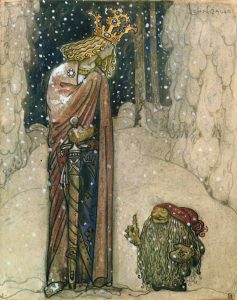Howling Tower
Saturday, February 16, 2019
Chase Scene Variations
Sunday, February 26, 2017
Cardtography 2: A Simple Dungeon
The second installment of Cardtography is up at Kobold Press.
We didn’t choose cards as our randomizers because they’re somewhat room-shaped. That’s a happy coincidence. The real reason is because they have information embedded on them, and we can use that information in all sorts of useful ways.
A playing card has two obvious bits of information: suit (clubs, diamonds, hearts, spades) and value (1-13). Those aren’t, however, the only way to classify their information. Suits can be reduced to red or black, and value can be looked at as 1-10 plus face cards. With so much encoded information to play with, we can combine bits to derive other values and create further groupings: odd black cards, for example, or red face cards.
Friday, February 3, 2017
Cardtography 1: The Basics
I have a new series of articles starting up over at Kobold Press this week. It's all about using a standard deck of playing cards to generate dungeon layouts and, in a larger sense, adventures. I'm pretty excited about it, because it's a topic and a system I've been playing with for years. Here's a taste:
My goal in this series of articles isn’t to put forward the ideal dungeon generator, whatever that might be. It’s not to put forward the most comprehensive, the most flexible, or the one that’s most likely to please everyone. It’s to put forward a generator that’s easy and FAST to use. One that doesn’t require a lot of materials, cross-checking pages of tables, or even drawing a map. Instead of using tables and dice, it uses a standard deck of 52 playing cards (54 when the jokers are included, which they sometimes are) and plenty of six-sided dice. One of those plastic boxes of 36 12mm dice is perfect, but any d6s will do.
This system is fast enough to use on the fly in the middle of a game session. It could be used by a solo player or by a group without a GM. When a GM is involved, it still pays to create the dungeon ahead of time and do some critical thinking about how it can be improved and made more logical (not necessarily the same thing). But if you need a dungeon NOW for a no-prep game session or to kill some time in solo exploration, this will do the trick.
Sunday, July 26, 2015
Rendezvous with Ruinator—Download!
I put adventure in quotes up there because this is an adventure in only the loosest sense. It's really a set of notes that I used to run the adventure from. There are no stats, no numbers, no charts. Unique monsters, NPCs, and hazards are mentioned without any guidance on what they look like or what their abilities are. The whole thing is only 8 pages, including a cover and two-page map, and the map is only a schematic; it shows where places are in relation to other places but doesn't include doors or hallways.
That's how I enjoy running adventures at NTRPGCon—I rough out a general plan and then have the greatest fun riffing off the players' ideas and interactions. That goes double for Gamma World—I have a core group of terrific players who make it to my GW game every year, and they never fail to amaze me with their inventiveness and humor. With a group like that, the adventure practically writes itself.
I use 1st-edition Gamma World rules for these sessions in Dallas, but any post-apocalyptic game will work for Rendezvous with Ruinator. Mutant Future from Goblinoid Games and Broken Urthe from Wizardawn Entertainment are both fine, free, OSR alternatives, if you don't have a copy of Gamma World lurking on your shelves anymore.
A bit of background might help GMs get into this. My Dallas GW adventures are all based around the framing story of Professor Monkey, a super-intelligent chimp who roams Gamma Terra at the helm of the lumbering "Radium Powered Lab." Think a CDC emergency-response laboratory on legs, built in the wacked-out 23rd century. Prof. Monkey is part altruistic world-saver and part megolamaniacal empire-builder. He's assembled a crack team of lab assistants (who are always busy doing science at the Radium Powered Lab) and go-fers (the "#1 Fetch-It Squad"), who do the dangerous work of venturing out into the irradiated wilderness to investigate enigmas and bring artifacts back to the lab. Those are the PCs. With Prof. Monkey as a patron, the characters can start these adventures well-equipped and with a definite mission—which usually is, "find out what this funny blip on the Scan-o-Tron 360 is and bring me back something I can use from it."
Ruinator is a gigantic war machine a third of a mile long with a complex, thoroughly dysfunctional society living inside it. You could be forgiven for thinking that an adventure set inside an ancient war machine might lean heavily on the combat lever, but this is actually one of the most diplomacy-rich settings I've ever concocted. There's plenty of opportunity for whipping guns out of holsters and slicing off arms with vibroblades, but in the end, talking is what's going to win the day inside Ruinator.
And that's enough talking from me. Download Ruinator and have fun!
Tuesday, May 26, 2015
Expect Things to Go Wrong
 Now at Kobold Press. (This is the fifth installment in a series of articles for players hoping to get the best possible experience from their time around the RPG table.)
Now at Kobold Press. (This is the fifth installment in a series of articles for players hoping to get the best possible experience from their time around the RPG table.)“Adventures, in retrospect, are pieces of extremely bad luck that missed a fatal ending.”
―Lawrence Griswold, Tombs, Travel and Trouble
It’s a shame that Lawrence Griswold isn’t better known these days. He was a real-life Indiana Jones, a Harvard-educated anthropologist and archaeologist who spent most of the 1920s and ‘30s carving trails through Guatemalan jungles in search of Mayan ruins and exploring the then-”lost world” island of Komodo, south of Borneo, where his expedition was the first to capture a live, adult Komodo dragon. A memoir of his adventures, Tombs, Travel and Trouble, was published in 1937, wherein he offered the humorously cynical view of adventure quoted above.
However much Griswold objects that “while (adventures) were happening to me, I cannot ever remember having been particularly pleased at the occasion,” or that he was generally “scared to death, too busy to think about it at all, or just damned annoyed” while his adventures were taking place, it’s obvious that in hindsight he loved every moment of it and wouldn’t trade his experiences for anything.
It would be foolish to expect adventures in roleplaying games to go any smoother than they do in real life. In fact, since our tabletop escapades never result in anyone really getting killed, injured, maimed, scarred, trapped in a labyrinthine tomb, or cast adrift in a rudderless boat for five days without water, they can afford to be even more thrill-filled than the real thing, the way a roller-coaster ride is more thrilling than a drive on the freeway.
Read the rest at Kobold Press ...
Friday, May 8, 2015
Dive Into the Unknown
“… Isn’t it splendid to think of all the things there are to find out about? It just makes me feel glad to be alive―it’s such an interesting world. It wouldn’t be half so interesting if we knew all about everything, would it?”
― L.M. Montgomery, Anne of Green Gables
In what I consider to be the very best types of roleplaying adventures and campaigns, both characters and players face situations where they don’t understand what’s happening and they’re being pushed to make decisions without crucial information. Sometimes they’re faced with a mystery, and filling in the missing information is the point of the adventure. Your opinion on that type of play might be different from mine; certainly there are players who like to feel as if they’re in control of the situation all the time. I don’t begrudge them their preference, but I do believe that they’re missing out on a huge quotient of enjoyment.
Most RPG settings are worlds of wonder. Whether you’re playing a fantasy game with magic and mythical beasts, a science fiction game with starships and aliens, a steampunk game with super-science and dinosaurs, or a post-modern game with vampires and murderous cults, the setting is rife with amazing things that don’t exist in real life. Experiencing the “wonders of the world” and uncovering its hidden truths can be a major thrust of the campaign, or it might be a sidelight. Either way, if players understand everything there is to know about the setting and the story they’re involved in, then I’d argue that the GM has made the world too small and too familiar.
Read the rest at Kobold Press ...
Steve
Wednesday, March 25, 2015
A Need for Speed
"Take time to deliberate, but when the time for action comes, stop thinking and go in.”
―Napoléon Bonaparte
A combat turn in most RPGs represents 5 to 10 seconds. If you spend much more time than that deciding what to do on your turn, you’re wasting time.That doesn’t mean your turn can’t take more than 10 seconds. It means you should answer the basic question, “what am I going to do this turn?,” in 10 seconds or less. Figuring out specifically how your character performs the chosen action within the allowances and restrictions of the rules can take substantially longer than that, especially if a fancy maneuver, an unusual weapon, or a complex magic spell is involved. But the basic question—”What am I going to do this turn?”—should be made quickly.
Read the rest at KoboldPress.com.
Steve



